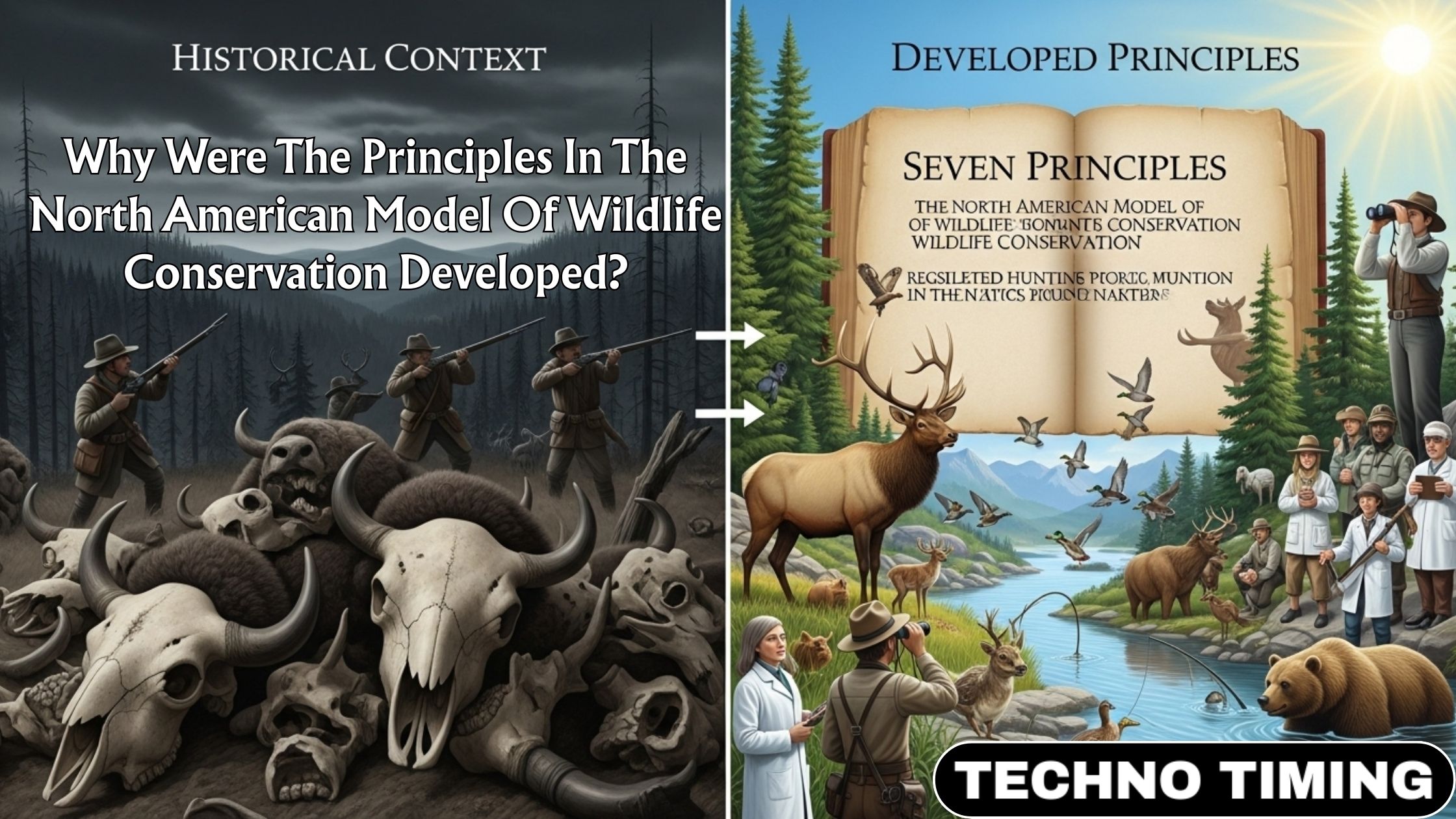The Origins of the North American Model of Wildlife Conservation Explained
The Question: Why the North American Model of Wildlife Conservation Was Created? The North American Model of Wildlife Conservation stands as one of the most successful wildlife management systems ever developed. But what drove its creation, and why has it become the gold standard for conservation efforts worldwide?
The answer lies in a conservation crisis that nearly destroyed North America’s wildlife heritage forever. By the late 1800s, unregulated hunting and rapid habitat destruction had pushed countless species to the brink of extinction. The passenger pigeon—once so abundant that flocks darkened the sky—vanished entirely. Bison herds that once numbered in millions dwindled to fewer than 1,000 animals. White-tailed deer populations collapsed across their native range.
This environmental catastrophe sparked an unprecedented response from hunters, anglers, and conservationists who recognized that without immediate action, future generations would inherit a continent stripped of its natural wealth. Their solution became the North American Model of Wildlife Conservation—a revolutionary approach that transformed wildlife from a commodity to be exploited into a public trust to be protected.
The Crisis That Changed Everything
Market hunting dominated the late 1800s, with professional hunters harvesting wildlife purely for profit. Passenger pigeons were slaughtered by the millions and shipped to urban markets. Bison were hunted primarily for their hides, leaving countless carcasses to rot on the plains. Waterfowl populations plummeted as market hunters used massive punt guns to kill hundreds of birds with a single shot.
The destruction wasn’t limited to hunting. Rapid westward expansion eliminated vast stretches of habitat as forests fell to logging operations and prairies transformed into farmland. Railroad construction fragmented remaining wildlife corridors, while industrial development polluted waterways that served as critical breeding grounds.
Species extinctions became a regular occurrence. The great auk disappeared from North American waters. The Labrador duck vanished without a trace. The passenger pigeon, despite being the most abundant bird species on the continent, was driven to extinction by 1914 when the last individual died in captivity.
Visionary Leaders Step Forward
Faced with this ecological disaster, a group of influential hunters and conservationists mobilized to save what remained of North America’s wildlife. Theodore Roosevelt, who would later become president, witnessed firsthand the devastation during his hunting expeditions in the Dakota Territory. George Bird Grinnell, editor of Forest and Stream magazine, used his platform to advocate for conservation measures.
Together, Roosevelt and Grinnell founded the Boone and Crockett Club in 1887, creating an organization dedicated to promoting ethical hunting practices and wildlife conservation. The club attracted wealthy sportsmen who possessed both the political influence and financial resources necessary to drive legislative change.
These conservation pioneers understood that protecting wildlife required more than good intentions—it demanded enforceable laws, dedicated funding, and professional management based on scientific principles. Their efforts culminated in landmark legislation that would reshape wildlife management forever.
The Foundational Laws
The Lacey Act of 1900 marked the first major victory for the conservation movement. Sponsored by Congressman John Lacey, a member of the Boone and Crockett Club, this law prohibited the transportation of illegally killed wildlife across state lines and effectively ended commercial market hunting.
The Migratory Bird Treaty Act of 1918 established international cooperation for protecting migratory species, recognizing that wildlife conservation required coordination across political boundaries. The act made it illegal to hunt, capture, or kill migratory birds without proper permits.
Perhaps most importantly, the Federal Aid in Wildlife Restoration Act—commonly known as the Pittman-Robertson Act—was passed in 1937. This legislation created an excise tax on firearms and ammunition, with revenues dedicated exclusively to wildlife conservation efforts. Hunters essentially taxed themselves to fund the restoration of the wildlife they loved to pursue.
The Sport Fish Restoration Act (Dingell-Johnson Act) followed in 1950, applying similar principles to fishing equipment and creating a comprehensive funding mechanism for both terrestrial and aquatic conservation efforts.
The Seven Pillars of Conservation
These legislative achievements established the foundation for what became known as the North American Model of Wildlife Conservation, built upon seven core principles:
Wildlife as Public Trust Resources
Wildlife belongs to all citizens, not to private landowners or commercial interests. Government agencies manage these resources on behalf of the public, ensuring that current and future generations can enjoy wildlife and wild spaces.
Prohibition on Commerce of Dead Wildlife
Commercial hunting and the sale of wildlife are prohibited to ensure population sustainability. This principle eliminates the profit motive that drove species toward extinction during the market hunting era.
Rule of Law
Democratic processes create laws and regulations that govern wildlife use. Public input shapes conservation policies, ensuring that management decisions reflect the will of the people rather than the interests of a privileged few.
Legitimate Purpose Requirement
Wildlife may only be killed for valid reasons—food, fur, self-defense, or property protection. Laws prohibit the casual killing of animals merely for trophies or the wasteful destruction of game meat.
Wildlife as International Resource
Since wildlife migrates freely across political boundaries, conservation requires international cooperation. Treaties and agreements between nations ensure coordinated management of shared species.
Scientific Management
The best available science guides wildlife management decisions. Professional biologists and wildlife managers base policies on research and data rather than political pressure or public opinion alone.
Democratic Opportunity
Every citizen in good standing has the legal right to hunt and fish, regardless of wealth, social status, or land ownership. This democratic principle ensures equitable access to wildlife resources.
Funding the Future
The North American Model created a unique “user-pays, public-benefits” funding system that remains the backbone of wildlife conservation today. Hunters and anglers contribute through:
- License fees paid directly to state wildlife agencies
- Federal excise taxes on hunting and fishing equipment
- Federal Duck Stamp purchases for waterfowl habitat conservation
- Boat fuel taxes supporting aquatic habitat restoration
Since 1937, this system has generated over $25.5 billion for wildlife conservation, with a record $1.5 billion distributed to states and territories in 2022 alone. These funds comprise approximately 75% of state wildlife agency budgets, supporting not only game species but all wildlife within their jurisdictions.
Remarkable Conservation Successes
The results speak for themselves. White-tailed deer populations have rebounded from near extinction to sustainable levels across their range. Wild turkey populations, decimated by habitat loss and overhunting, now thrive in every state. Waterfowl species have recovered dramatically, with some populations exceeding historical levels.
The North American Model has prevented the extinction of countless species while maintaining robust populations that support both hunting opportunities and ecosystem health. Professional wildlife managers use scientific research to set appropriate harvest quotas, ensure adequate breeding populations, and protect critical habitats.
Colorado provides an excellent example of the Model’s success. Species like lynx, moose, black-footed ferrets, elk, and turkeys have all benefited from conservation programs funded through hunting and fishing license sales and equipment taxes.
Supporting Conservation Through Action
The North American Model demonstrates that effective conservation requires both philosophical commitment and practical funding mechanisms. By establishing wildlife as a public trust resource managed through scientific principles, the Model created a sustainable framework for protecting natural heritage.
Understanding this history helps explain why hunting and conservation remain so closely linked. Rather than being opposing forces, regulated hunting and wildlife conservation work together to ensure that future generations inherit the same abundant wildlife that previous generations nearly lost forever.
The success of the North American Model offers valuable lessons for conservation efforts worldwide, proving that when user communities invest in resource protection, both wildlife and people benefit from the results.
Common Questions About the North American Model
What Makes This Model Unique Globally?
The North American Model is unique because it combines democratic participation, scientific management, and sustainable funding into one comprehensive system. Unlike European models based on land ownership or Asian approaches emphasizing cultural traditions, the North American system prioritizes public ownership and equal access.
How Do the Principles Work Together?
The seven principles create an interconnected system where each element supports the others. Public trust ensures equal access, scientific management guides decisions, democratic allocation prevents over-exploitation, and sustainable funding makes it all possible.
Who Benefits from This Model?
While hunters and anglers fund the system, everyone benefits. Hikers, photographers, birdwatchers, and families enjoying outdoor recreation all benefit from the abundant wildlife and protected habitats maintained through this model.
What Role Does Science Play?
Science provides the foundation for all management decisions. Wildlife biologists study population dynamics, habitat requirements, and ecosystem health to ensure sustainable harvest levels and effective conservation strategies.
What are the 7 principles of the North American Model of Wildlife Conservation?
The 7 principles are:
- Wildlife is a public resource
- Markets for game are prohibited
- Wildlife is managed by law
- Science guides management
- Hunting is a tool for conservation
- Democracy in wildlife management
- International cooperation is essential
Why is the North American Model of Wildlife Conservation important?
The model helps to ensure the protection and sustainable management of wildlife resources. It supports the balance between human activity and environmental preservation, ensuring future generations can benefit from healthy ecosystems.
How did hunters contribute to the North American Model of Wildlife Conservation?
Hunters played a crucial role in the model’s development by advocating for sustainable hunting practices and recognizing the need for regulation to ensure wildlife could thrive. Their efforts led to the creation of conservation laws that have benefited both hunting communities and wildlife populations.
What makes the North American Model unique?
Unlike other conservation models, the North American Model emphasizes public ownership of wildlife, scientific research, and democratic involvement in wildlife management, making it a comprehensive and inclusive approach to conservation.
What is the main idea behind the North American Model of Wildlife Conservation?
The core idea is that wildlife is a public resource held in trust by the government for the benefit of all citizens, now and in the future. It’s meant to be managed scientifically and allocated by law, ensuring its populations are sustained forever.
Who were the key figures behind creating the model?
While the model evolved over time, early conservation leaders like President Theodore Roosevelt, George Bird Grinnell (founder of the Boone and Crockett Club), and Aldo Leopold were instrumental in developing its core philosophies and advocating for conservation laws.
Which principle was most critical in starting the North American Model of Wildlife Conservation?
The Public Trust Doctrine is arguably the most foundational principle. The idea that wildlife belongs to everyone, not individuals, and must be managed for the public good was a radical departure from the past and serves as the cornerstone for all other principles in the model.
Why is the North American Model of Wildlife Conservation so successful?
Its success comes from a powerful combination of factors:
- Public Ownership: Treating wildlife as a public trust gives every citizen a stake in its well-being.
- Scientific Management: Basing decisions on data ensures sustainable populations.
- Dedicated Funding: The user-pays system provides a consistent and reliable source of money for conservation work.
- Engaged Citizens: Democratic access created millions of hunters and anglers who act as dedicated stewards of the resource.
Who Developed the North American Model of Wildlife Conservation?
It was shaped by sportsmen, hunters, and leaders like Roosevelt and Leopold in the early 1900s, building on 19th-century efforts.
What Are the Two Basic Principles of the North American Model of Wildlife Conservation?
The core duo: Wildlife is for non-commercial use by citizens, and it should be managed sustainably forever.
Is the North American Model of Wildlife Conservation Successful?
Absolutely—it’s restored countless species and is a global benchmark, though it faces modern tweaks for inclusivity.
This comprehensive guide explores the historical context, key figures, and enduring principles that make the North American Model of Wildlife Conservation the world’s most successful wildlife management system. Understanding why these principles were developed helps us appreciate not just their historical significance, but their continued relevance in modern conservation efforts.
Also Read: When Will You Get A Restricted Government Travel Card Individually


